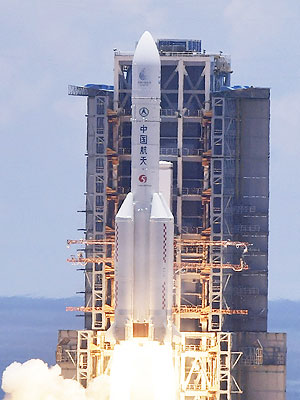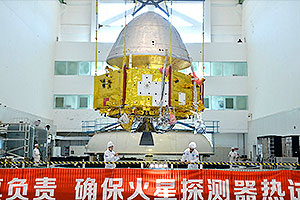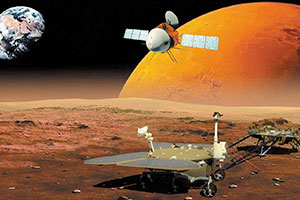July 23, 2020 – China's first try at landing on Mars is on its way to the Red Planet.
The China National Space Administration's (CNSA) Tianwen-1 mission, which includes an orbiter, a lander and a rover, launched on Thursday (July 23) from the Wenchang Satellite Launch Center on Hainan Island, located in the South China Sea. The spacecraft lifted off at 12:41 a.m. EDT (0441 GMT; 12:41 p.m. local) atop China's largest launch vehicle, a Long March-5 rocket, on its first operational flight.
Inserted into an Earth-Mars transfer orbit about 36 minutes after the launch, the Tianwen-1 spacecraft is now on a path to arrive at Mars in February 2021. CNSA did not release a specific date for the arrival, leaving open an uncertainty as to whether the country will become the fifth or sixth country to place a vehicle into orbit around Mars.
To date, the United States, Russia, the European Space Agency and India have successfully operated robotic probes above Mars. The United Arab Emirates' (UAE) first mission, "Hope" (or "Al-Amal"), is also set to arrive and enter Mars orbit in February having launched from Japan on Sunday (July 19).
The Tianwen-1 lander and rover will stay in Mars orbit through April or May, prior to descending to the surface using a combination of an aeroshell, parachute and thruster to brake and cushion their touchdown.
"The lander/rover will perform a soft landing on the Martian surface some 2 to 3 months after arrival of the spacecraft, with a candidate landing site in Utopia Planitia," the mission's chief scientist, Wan Weixing, wrote in a paper published this month in Nature Astronomy. (Wan died in May after falling ill.)
With a name that translates to "questions to heaven," borrowed from an ancient Chinese verse by the poet Qu Yuan, the Tianwen-1 mission aims to conduct a global survey of Mars, from orbit and on the ground. The probes are designed to conduct investigations about the planet's geological structure, environment and atmosphere.
"Specifically, the scientific objectives of Tianwen-1 include: to map the morphology and geological structure; to investigate the surface soil characteristics and water-ice distribution; to analyze the surface material composition; to measure the ionosphere and the characteristics of the Martian climate and environment at the surface; and to perceive the physical fields (electromagnetic, gravitational) and internal structure of Mars," wrote Wan.
The mission includes 13 science instruments, with seven mounted to the orbiter and six on the solar-powered, six-wheeled rover. The rover is designed to operate for 90 Martian days.
The Tianwen-1 mission is China's second attempt at orbiting Mars. The country's Yinghuo-1 orbiter was launched with Russia's Phobos-Grunt mission in 2011, but its rocket failed before leaving Earth orbit.
The Tianwen-1 rover builds off China's experience operating wheeled vehicles on the moon, though it is nearly twice the mass of the Yutu lunar rovers.
If the Tianwen-1 lander and rover make it safely down, China will become the third nation to land a spacecraft on Mars and the second to rove the surface. To date, the U.S. and Russia have been the only countries to land probes and the U.S. has sent the only rovers.
"Tianwen-1 is going to orbit, land and release a rover all on the very first try, and coordinate observations with an orbiter," wrote Wan. "No planetary missions have ever been implemented in this way."
"If successful, it would signify a major technical breakthrough," he said.
The Tianwen-1 orbiter and lander were built by the China Aerospace Science and Technology Corporation. The mission is managed by the National Space Science Center of the Chinese Academy of Sciences in Beijing. |
|

China's Long March 5 rocket topped with the Tianwen-1 spacecraft launches on the country's first mission to land on Mars. (CNSA)

China's Tianwen-1 spacecraft is seen being prepared for its launch to orbit and land a rover on Mars. (CASC)

Artist's concept of China's Tianwen-1 Mars mission, including its orbiter, lander and rover. (CNSA/Chinese Academy of Sciences) |
